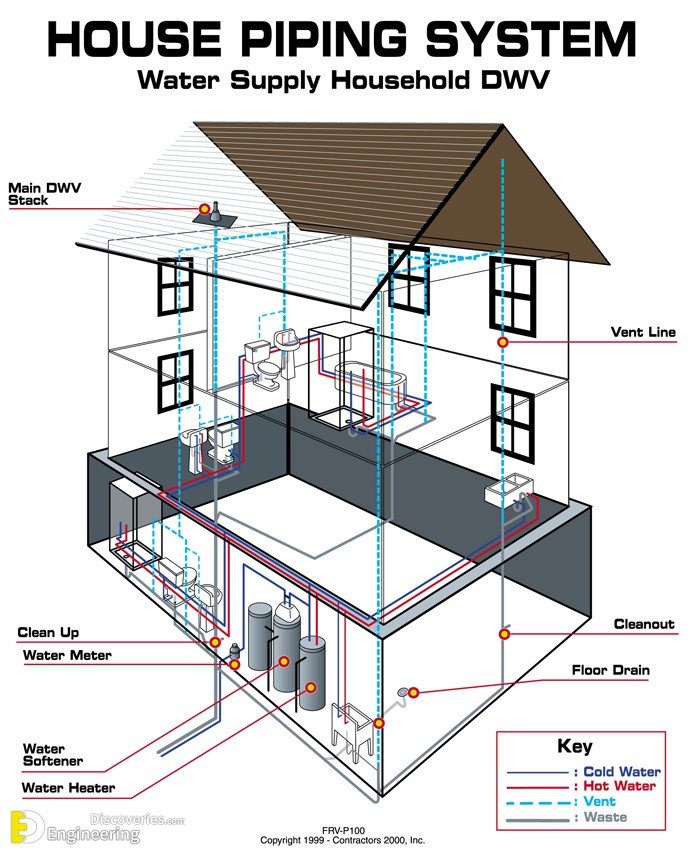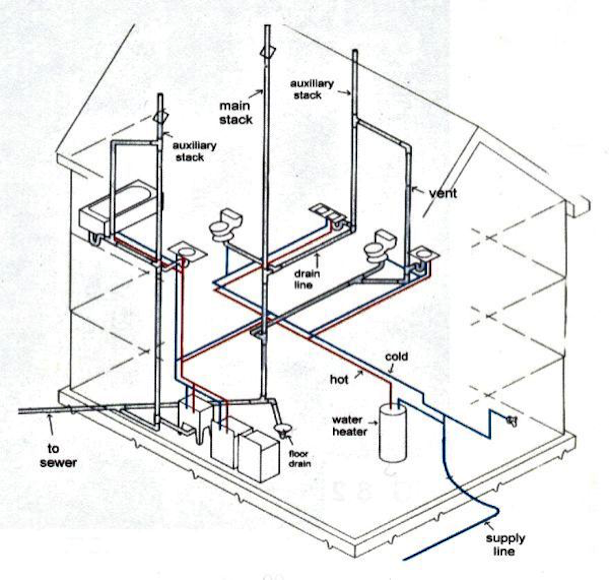We have stumbled on this great article about Understanding Your Home's Plumbing Anatomy down the page on the web and decided it made perfect sense to quickly share it with you in this article.

Understanding how your home's plumbing system works is important for every property owner. From providing clean water for drinking, food preparation, and showering to securely getting rid of wastewater, a properly maintained pipes system is critical for your household's health and wellness and comfort. In this extensive guide, we'll explore the intricate network that makes up your home's plumbing and deal ideas on maintenance, upgrades, and dealing with common concerns.
Introduction
Your home's plumbing system is greater than just a network of pipelines; it's a complex system that guarantees you have accessibility to tidy water and effective wastewater elimination. Recognizing its components and how they interact can assist you avoid costly repairs and make certain whatever runs efficiently.
Basic Elements of a Plumbing System
Pipes and Tubes
At the heart of your plumbing system are the pipelines and tubing that lug water throughout your home. These can be made from numerous materials such as copper, PVC, or PEX, each with its benefits in terms of longevity and cost-effectiveness.
Fixtures: Sinks, Toilets, Showers, and so on.
Fixtures like sinks, commodes, showers, and bathtubs are where water is used in your house. Understanding exactly how these fixtures link to the pipes system assists in detecting issues and intending upgrades.
Shutoffs and Shut-off Points
Shutoffs control the circulation of water in your plumbing system. Shut-off valves are critical throughout emergencies or when you require to make repairs, enabling you to separate parts of the system without interrupting water circulation to the whole home.
Water System
Main Water Line
The primary water line attaches your home to the community supply of water or a personal well. It's where water enters your home and is distributed to different components.
Water Meter and Stress Regulatory Authority
The water meter actions your water use, while a stress regulator ensures that water flows at a safe pressure throughout your home's plumbing system, preventing damages to pipelines and components.
Cold Water vs. Warm water Lines
Understanding the difference between cold water lines, which provide water directly from the major, and warm water lines, which carry heated water from the hot water heater, assists in repairing and preparing for upgrades.
Drainage System
Drain Water Lines and Traps
Drain pipelines lug wastewater far from sinks, showers, and toilets to the drain or sewage-disposal tank. Traps avoid sewer gases from entering your home and also trap debris that might trigger obstructions.
Air flow Pipelines
Air flow pipes allow air into the drainage system, avoiding suction that can slow down drain and cause catches to vacant. Appropriate ventilation is important for maintaining the integrity of your pipes system.
Relevance of Appropriate Drain
Guaranteeing proper water drainage protects against back-ups and water damages. Routinely cleaning drains pipes and maintaining traps can stop costly repair services and extend the life of your plumbing system.
Water Heating System
Types of Hot Water Heater
Hot water heater can be tankless or standard tank-style. Tankless heating units warm water on demand, while storage tanks save warmed water for prompt usage.
Updating Your Plumbing System
Reasons for Updating
Upgrading to water-efficient fixtures or replacing old pipelines can boost water high quality, decrease water bills, and increase the worth of your home.
Modern Plumbing Technologies and Their Advantages
Check out technologies like clever leak detectors, water-saving bathrooms, and energy-efficient water heaters that can conserve money and lower ecological influence.
Cost Factors To Consider and ROI
Calculate the in advance costs versus lasting savings when thinking about plumbing upgrades. Several upgrades pay for themselves with reduced utility costs and fewer repair services.
How Water Heaters Connect to the Pipes System
Understanding just how water heaters link to both the cold water supply and warm water distribution lines helps in detecting issues like not enough hot water or leaks.
Upkeep Tips for Water Heaters
On a regular basis flushing your water heater to eliminate debris, checking the temperature level settings, and checking for leakages can expand its life expectancy and boost energy effectiveness.
Usual Plumbing Problems
Leakages and Their Causes
Leaks can take place due to aging pipelines, loose installations, or high water pressure. Addressing leakages immediately avoids water damages and mold and mildew growth.
Obstructions and Obstructions
Obstructions in drains and commodes are often triggered by purging non-flushable products or a build-up of grease and hair. Utilizing drainpipe displays and being mindful of what goes down your drains can protect against clogs.
Indications of Plumbing Issues to Expect
Low water pressure, slow-moving drains, foul odors, or uncommonly high water costs are indicators of prospective plumbing troubles that should be dealt with quickly.
Plumbing Maintenance Tips
Routine Assessments and Checks
Set up yearly pipes assessments to capture concerns early. Look for signs of leakages, rust, or mineral accumulation in taps and showerheads.
Do It Yourself Upkeep Tasks
Simple tasks like cleansing tap aerators, looking for toilet leaks using dye tablet computers, or shielding exposed pipelines in cold climates can stop significant pipes problems.
When to Call a Specialist Plumbing Professional
Know when a plumbing issue needs expert expertise. Attempting complicated repair services without correct understanding can result in even more damages and higher fixing expenses.
Tips for Decreasing Water Use
Straightforward routines like taking care of leaks without delay, taking much shorter showers, and running complete tons of laundry and dishes can preserve water and lower your utility costs.
Eco-Friendly Pipes Options
Take into consideration sustainable plumbing materials like bamboo for flooring, which is durable and environment-friendly, or recycled glass for kitchen counters.
Emergency situation Readiness
Actions to Take During a Plumbing Emergency
Know where your shut-off valves lie and just how to switch off the water in case of a burst pipe or major leak.
Relevance of Having Emergency Situation Get In Touches With Handy
Maintain get in touch with info for regional plumbings or emergency situation solutions conveniently offered for fast feedback throughout a plumbing crisis.
Ecological Effect and Conservation
Water-Saving Components and Home Appliances
Setting up low-flow faucets, showerheads, and commodes can considerably reduce water use without giving up performance.
Do It Yourself Emergency Situation Fixes (When Applicable).
Short-term repairs like using air duct tape to patch a dripping pipe or positioning a bucket under a trickling tap can reduce damages until an expert plumber gets here.
Conclusion.
Comprehending the makeup of your home's pipes system equips you to keep it efficiently, conserving time and money on repairs. By complying with regular maintenance routines and remaining informed regarding modern-day plumbing technologies, you can guarantee your pipes system operates efficiently for several years ahead.
Understanding Your Home Plumbing System: A Comprehensive Guide
Plumbing System: The Lifeline of Your Home
At its core, the plumbing system is designed to perform two primary functions: bring fresh water into your home and remove wastewater. The system is a network of pipes, fixtures, and other components that transport water and sewage. Residential plumbing systems include potable water supply lines, drain-waste-vent (DWV) systems, and various plumbing fixtures that make water use in daily tasks possible.
Key Components:
Water Supply: This part of your plumbing system brings municipal water into your home, passing through the main water supply line. It s responsible for supplying all water needs, from drinking to bathing.
Drainage System: It carries waste and water away from your home to the sewer or septic system. This system includes all the piping within your home that leads to external sewage or septic systems.
Vent System: An essential yet often overlooked component, the vent system allows sewer gases to escape and lets air into the drainpipes, ensuring water and waste move correctly through the system.
Fixture: More Than Just Taps and Toilets
Plumbing fixtures are the most interactive parts of the plumbing system, including faucets, showers, toilets, and sinks. Each fixture is connected to the plumbing system and plays a role in either the delivery of freshwater or the disposal of waste and wastewater.
Types of Fixtures:
Faucets and Sinks: Used for washing hands, dishes, and other daily water needs. Toilets: Dispose of human waste through the sewage system. Bathtubs and Showers: Provide bathing facilities, requiring both hot and cold water supply. Water Supply: The Source of Life
The water supply system is a critical component, ensuring that potable water is available throughout your home for various uses, including drinking, cooking, and cleaning. This system consists of pipes that distribute water to different parts of the house, controlled by valves to regulate the water flow.
Types of Plumbing: Materials and Methods
Various types of plumbing systems and materials are used in residential settings, each with its advantages and applications. From copper and PVC pipes for water supply to cast iron and ABS for drainage, the choice of materials can impact the longevity and efficiency of your plumbing system.
https://intownplumbingtx.com/articles/home-plumbing-system-guide/

I hope you liked our excerpt on Understanding Your Home's Plumbing Anatomy. Thanks so much for spending some time to browse our posting. Are you aware of somebody else who is looking into the niche? Do not hesitate to promote it. Thanks a lot for being here. Don't forget to visit our website back soon.
Book 24/7